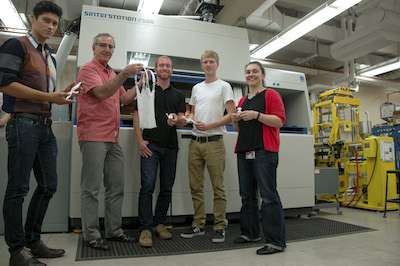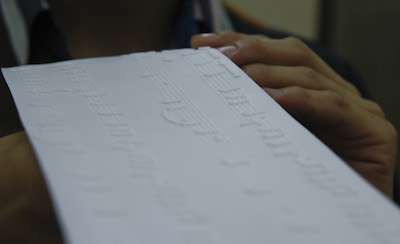Advanced 3-D printer sparks unique collaborations across campus

When the UW-Madison Mechanical Engineering Department acquired an advanced 3D printer in 2012, it not only increased the lab's research capabilities, but it also opened a door to new collaborations on campus.
Kuo K. and Cindy F. Wang Professor Tim Osswald, co-director of the Polymer Engineering Center (PEC), says the lab's 3D printer—a selective laser sintering (SLS) machine, purchased with funding from a $1.5 million gift from alumnus Robert Cervenka and his wife, Debbie—has been instrumental in forging creative projects involving people from various disciplines who might not typically work together.
"The SLS machine is a catalyst for new ideas and opportunities," Osswald says. "It's triggering interdisciplinary collaborations and new thinking among all kinds of people, which is really cool."
Unlike the consumer-level, desktop 3D printers that have received lots of media attention, the PEC's industrial SLS machine is a high-end, precision instrument—and about the size of a compact car.
Selective laser sintering is a 3D printing (or additive manufacturing) process that uses a laser to fuse, or sinter, powdered material together to create a solid 3D object from a computer-aided design (CAD) file. The SLS machine uses a roller to distribute a paper-thin layer of powdered polymer or metal onto the build bed, or platform. Then, the laser melts the powdered material by etching cross-sections of the object on the surface of the build bed. After each thin layer, or cross-section, is fused, the powder bed platform is lowered by a single layer and a new layer of powder is applied on top. This process repeats, building the object up, layer by layer, as the platform slowly sinks until the object is completed. The completed object is buried within the excess powder, which supports the object during the printing process and eliminates the need for printing dedicated support structures. This allows for more intricate designs and complex geometries than would be possible with other 3D printing or traditional manufacturing processes.
The SLS machine has enabled several unique collaborations across campus, and these efforts have resulted in novel 3D printing applications ranging from tactile music scores for a blind musician to 3D-printed textiles to a new tool that can help doctors plan better surgical procedures for children with congenital heart defects.
Although the PEC lab's SLS machine is often used by engineering students and faculty, mechanical engineering graduate student William Aquite says the PEC lab is also interested in forming new collaborations with students, faculty or staff at UW-Madison beyond the College of Engineering.
3D printing tactile music scores for the blind
One project began when Aquite saw a video profiling Yeaji Kim, who was completing her PhD in the School of Music. Kim, who is blind, plays piano using Braille scores. However, the scores are highly complex and yet can still lack some information traditionally included on sheet music. To address this challenge, Kim invented a system that essentially raises the type on top of the staff and notes on regular sheet music, giving the musical notation a tactile quality that a visually impaired musician could read by touch and a sighted person could also read visually. That invention, which opens up new possibilities in music education and accessibility, caught Aquite's attention.
Aquite, who researches 3D printing technology and processes in the PEC, realized he could use 3D printing to help Kim create 3D musical scores. He brought the idea to Osswald, and they approached Kim to collaborate.
"Kim was interested in the idea and definitely excited about collaborating," Aquite says. "This isn't just building a prototype for her or the School of Music. It's a true collaboration in that we're working closely with Kim to understand her design needs and to find solutions together."

A team of Osswald's undergraduate and graduate students has been working on the project, researching ways to improve the dimensional accuracy and surface quality of a 3D-printed music score. Since earning her PhD, Kim has returned home to South Korea, but her collaboration with the PEC continues. The team mails her the latest 3D-printed versions, and Kim gives feedback that informs the next iteration.
Collaboration with SoHE student results in 3D-printed textile
The SLS machine's ability to create intricate designs was key in another collaborative project, one that paired a student from the School of Human Ecology with a mechanical engineering student for an undergraduate research project. Osswald's daughter Ruth, a sophomore textile design student, was visiting home one day when she saw a sample of a textile that was 3D printed by some students in her dad's lab.
"My dad has always brought things from the lab home to show the family but that was the first thing that I could really get excited about because it was this cool textile created in an engineering lab, and I started getting so many ideas about what could be done with this technology," says Ruth.
She started talking with her dad about ways to improve on the textile sample, and that led to Ruth's summer project in the PEC lab to try out her ideas.
She teamed up with Darcy Davis, a mechanical engineering undergraduate student who knew how to use the engineering computer-aided design programs to design objects for 3D printing. "Once Darcy and I started working together, the project just took off and we came up with a lot of really awesome things," Ruth says.
They experimented with several different sizes and geometries for their textile design. Eventually, they designed a tank top made up of small interlocking rings, and printed it using a nylon polymer. They're now working on printing a full dress.
Tim Osswald says he was amazed by the outcome of the project. "It was once unthinkable that you could actually 3D print something like this, where each small ring in the textile is a separate element. It shows how it's just open to the imagination as to what you can create with this technology."
Patient-specific 3D models provide new tool for surgical planning
In yet another project, Alejandro Roldán-Alzate, a cardiovascular modeling scientist in the Department of Radiology in the University of Wisconsin School of Medicine and Public Health, is collaborating with Tim Osswald and mechanical engineering graduate student Neil Doll to 3D print patient-specific internal anatomies.
With a grant from the American Heart Association, Roldán-Alzate is researching an innovative way to plan and optimize surgical procedures for children born with single ventricle heart defects, a condition in which the heart has only one functionally pumping chamber, rather than two. Children born with this condition need to undergo a series of surgeries in their first couple years.
By using an MRI to scan a patient's heart defect, Roldán-Alzate generates a 3D model of the defective heart, which Doll and Osswald can 3D print. Roldán-Alzate then connects these 3D-printed models of the patient's arteries and blood vessels to a pump that simulates the blood circulation in the body, allowing him to run in vitro experiments outside the patient's body. He then uses the results from these blood flow experiments to help validate his computer simulations and to plan an optimal surgical procedure for the patient based on that patient's distinct anatomy.
"The role of 3D printing here is to make patient-specific 3D models that allow us to manipulate the conditions that we cannot change within the patient, things like elevating the heart rate," Roldan-Alzate says. "So 3D printing is allowing us to have a mockup of a patient in a system that we can control and run experiments on. We can't control the patient's cardiovascular system."
He says his goal is to be able to scan a newborn child with a heart defect and then, using these tools, design a surgery for that particular child. This optimized surgery would enhance the circulation and efficiency of blood flow, keeping the patient healthier for longer after a procedure.
SLS machine supports additive manufacturing research
While these diverse 3D printing projects point to innovative applications for 3D printing, the collaborations also are playing an important role in mechanical engineering and PEC research of the additive manufacturing process itself. "This process is very advanced, and there's a lot that needs to be done to make it even better," Aquite says. "It's a thermomechanical process, so there's shrinkage and warping going on due to thermal changes, and those have an influence on the finished part. So, one thing we're doing in our research is simulating that whole thermal process to predict dimensional changes in printed parts."
Other research involves studying how single particles move on the powder bed and interact with each other and how that motion and interaction affect the resolution of a single layer of a printed object. Here, Osswald's graduate students are collaborating with Mechanical Engineering Professor Dan Negrut's group in simulating the movement of millions of polymer powder particles when building up the layers during SLS printing. Negrut's multibody dynamics simulation program is helping them build smoother layers during the printing process, increasing the quality of the 3D-printed object.
In the meantime, mechanical engineering student and faculty researchers continue to pursue innovative applications for 3D printing. "With projects like these, we are pushing the envelope of the technology, which is really what we're supposed to be doing," Osswald says.
Provided by University of Wisconsin-Madison




















